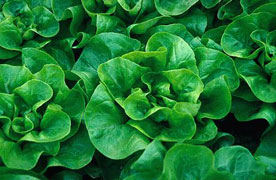


Home
Flowers &
Indoor Plants
Fruits & Nuts
Ornamentals
Vegetables
Special Topics
Resources
Glossary

Lettuce |
 |
What about it? Lettuce is in the Composite family with endive and dandelion. If you plan out your garden well, you can have a great lettuce crop continuously. There are 4 main lettuce types: butterhead, crisphead, looseleaf, and Romaine. Lettuce is about 95 percent water. What is it used for? The lettuce plant is edible and a great source of Vitamin A. Lettuce grows in a rosette, and in the center the leaves will sometimes form a head. Where does it grow? How do we grow it?Lettuce should be grown quickly, under cool conditions. If grown in hot weather, the lettuce will "bolt" and turn bitter. Mulching is very important when growing lettuce to keep the ground cool. The best results come from planting small amounts of lettuce throughout the growing season. Sow a new section of seeds every two weeks. Read the seed package; varieties take between 40 and 80 days to mature. What are its primary problems? Insects and diseases are rare in home gardens. Slugs may show up during a rainy period, and rabbits find it quite tasty. How do we propagate it? Lettuce is started from seeds. Plant the seeds 1/2 inch deep and 3 inches apart. They can also be started indoors and moved out as 3-4 week transplants. How do we harvest and store it? Harvest in the early morning when the leaves are crisp and moist. Leaf lettuce should be cut as soon as the leaves are big enough to eat. Head varieties should be harvested before they reach full size so that they will continue to produce. Once picked, keep the lettuce leaves out of the sun and cool.
© Copyright, Department of Horticulture, Cornell University. |
